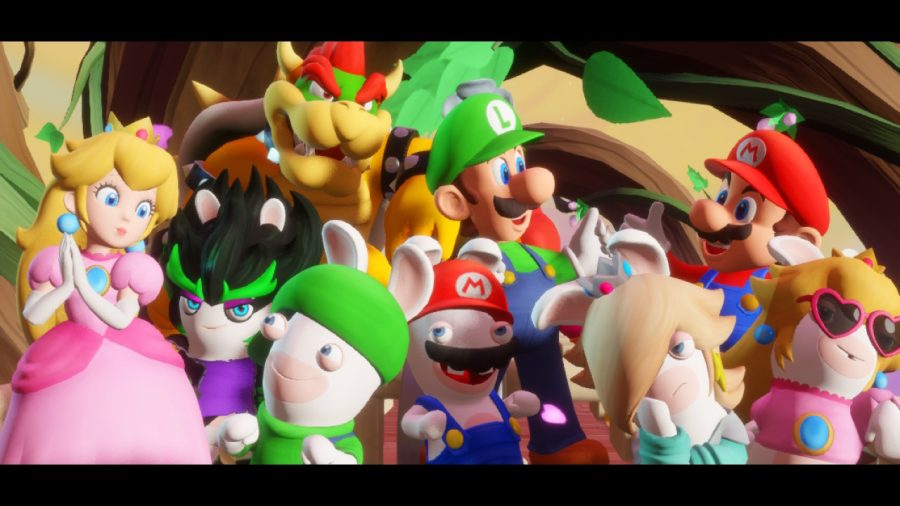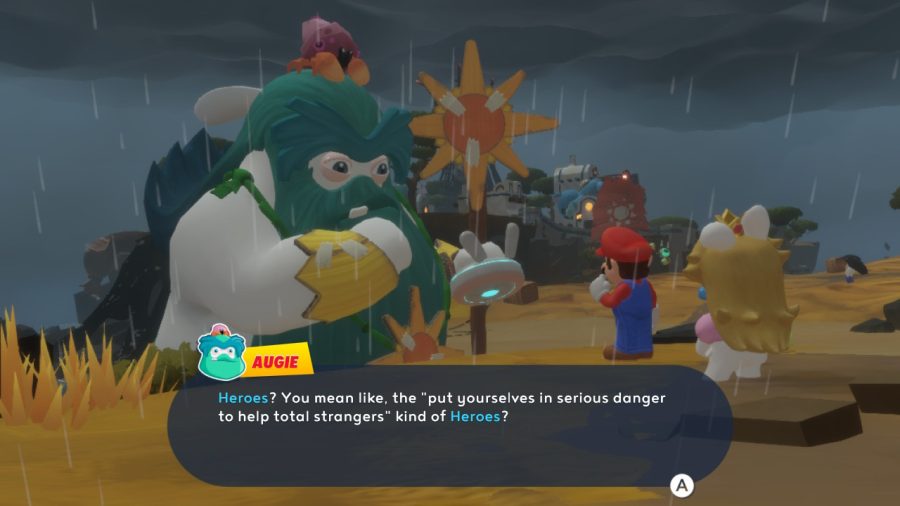When it was announced that Mario and the Rabbids were crossing over for a tactical role-playing game akin to the XCOM series, I didn’t think much of it. Little did I know I would find Mario + Rabbids Kingdom Battle to be one of the first games I owned on the Nintendo Switch as well as one of the hybrid console’s best early titles. Now the game has a sequel, and it’s just as good if not even better than its predecessor.
In Mario + Rabbids Sparks of Hope, Mario and company travel the galaxy to stop the mysterious villain Cursa who wields a power known as “Darkmess energy” (yes, with an “m”) and with its army seeks to absorb the power of the Sparks, special beings comprised of both Rabbid and Luma DNA.
While the first game felt like it took elements from both franchises in an even split, Sparks of Hope feels more like a Mario RPG such as the Paper Mario or Mario & Luigi series but with characters and imagery designed after the Rabbids. The game matches the humor of the aforementioned RPGs pretty well but also includes the situational gags involving Beep-O’s commentary that were present in Kingdom Battle.
The gameplay is split between field exploration and tactical battles. On the field, players can collect coins to buy items to use during battle, engage in battles or complete side quests to obtain either new Sparks or planet coins that can be used to purchase items exclusive to the current planet.
Side quests are extremely varied and consist of collecting colored coins, defeating three of an enemy roaming the map and solving puzzles, just to name a few. Each planet has an average of 25 side quests.
Battles are initiated by getting close to enemies in the field and pushing a button to dash into them, letting the enemy dash into you or by inspecting Darkmess puddles in the field. In battle, the player and the enemy teams take turns trying to take each other out with a variety of attacks while hiding behind cover to avoid taking damage. There are two kinds of cover that fill the battlefield: partial cover which will grant a 50% chance of not being hit and full cover which is guaranteed to prevent damage from being taken. Cover will progressively be destroyed if hit. Battles are not grid-based like in the first game, meaning that characters can freely roam within a limited space until they attack after which they cannot move.
Mario, Luigi, Princess Peach and their Rabbid counterparts return as playable characters alongside Bowser himself as well as the newcomers Rabbid Rosalina and the enigmatic Edge. Unlike before, there are no restrictions to the party’s composition, and to make things even better, all nine heroes play completely differently. Mario for example, can attack twice per turn on targets while Rabbid Peach will fire three arc shots at a single enemy that bypasses partial cover.
While most of the characters are designed with features of the Rabbids, the chaotic nature of the Rabbids have been heavily toned down in favor of making them unique characters with their own voices. Yes, the Rabbids have voice acting. During cutscenes and battles, the playable Rabbids will have their own voices to express their feelings and personality. While at first a bit jarring, I overall found it a nice change as it made them feel like actual characters rather than Rabbids in cosplay.
Characters are limited to one weapon and one technique but can equip up to two Sparks to alter their skill set.
Sparks either apply super effects to a hero’s attacks once activated or are used for utility. Super effects are element based with enemies having specific weaknesses or resistances to each while utilities can include reducing damage taken and damaging the attacker or preventing the user from being targeted among an assortment of other effects. The potency of the effects that Sparks provide increases with their individual level which can be increased by feeding them star bits which are obtained by defeating enemies or using star potions which can be found or purchased with planet coins.
In lieu of weapon upgrades, characters get stronger by obtaining experience points (EXP) from battles and leveling up. All characters gain the same amount of EXP and remain at the same level regardless of whether they were knocked out during the battle or didn’t participate at all.
Each character has their own skill tree that can be used to upgrade certain traits or abilities. Skill prisms, which are obtained by leveling up, are used to receive upgrades on each tree and can manually be refunded at any time should the player wish to invest in another trait.
In terms of difficulty, Sparks of Hope has three difficulty settings which can be changed at any time and while I played the entire game on the “Average” difficulty, I felt as if it was just a tad easier than Kingdom Battle. However, I also found there to be a linear difficulty curve in which the game got gradually harder the further in. Even early on though I found that using characters unsuited to the objective made the battle much harder while using the correct characters made the fight either adequately difficult or much easier.
There was no noticeable penalty for letting an ally get knocked out which I didn’t mind as it expanded the scope of potential strategies, enabling me to sacrifice an ally if the need arose.
Grant Kirkhope returns for the soundtrack, this time in collaboration with Yoko Shimomura and Gareth Coker. All three composers bring out their individual styles for each of their respective tracks. Despite the different styles, there’s a sort of synergy for each of the tracks that make each track come together to form a stellar soundtrack that adds to the gameplay in an extremely satisfying way.
Before I make the game sound flawless, I will mention that there were a couple things I noticed that could be considered flaws.
There were a few issues in terms of performance. Two or three times during my playthrough I encountered noticeable frame drops and there were more than a few instances of pop-in. While this can be taken as a negative it personally didn’t bother me in the slightest.
The voice acting is also largely inconsistent. Most characters will have a short voice clip or generic sound or grunt to go alongside the textbox when they speak, yet the returning Beep-O and the ship’s artificial intelligence, Jeanie, are fully voiced meaning that every word of their text boxes are spoken. This inconsistency bothered me at first but as the game progressed I eventually got used to it.
Mario + Rabbids Sparks of Hope is an amazing sequel to an already surprisingly good game. It has many differences from its predecessor, yet it’s still recognizable as a sequel that expanded greatly upon what came before. While it’s fine to wait for a sale since the first game has dropped in price frequently, I’d say that Sparks of Hope is still very much worth the full price.





